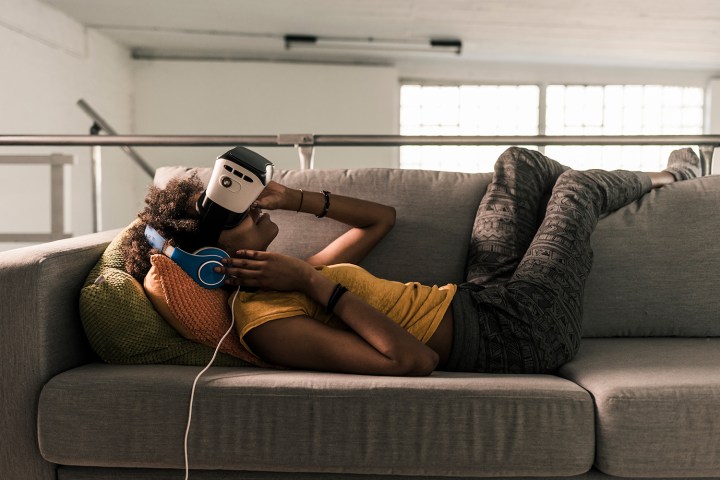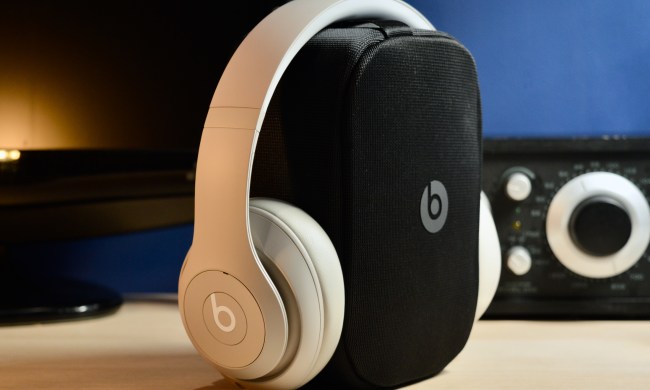
But let’s be honest; watching other people pretend isn’t exactly the prize you worked all day to earn. So why not climb Everest instead? Or maybe drink that beer on a tropical beach as you talk trash to your friends, whose avatars are playing volleyball nearby? Hell, instead of spectating as actors perform that train heist, why don’t you leap from the back of a horse onto the speeding train? Wouldn’t you prefer to be the one throwing the touchdown pass for your favorite sports team rather than simply watching someone else get all the glory?
In the future, post-work relaxation isn’t about turning off and becoming passive.
In the future, post-work relaxation isn’t about turning off and becoming passive. It’s about coming alive to celebrate your freedom from the grind. It’s about selecting from an endless catalogue of visceral simulations and virtual realities that we can live inside and participate in, letting us become a part of the story rather than merely watching it pass by in front of us.
Studies have shown that VR headsets successfully hijack our brains in a way TV never has, giving users a sense of “presence” by blocking out all the cues that normally ground us to reality. Our limbic systems activate, and our bodies and minds suddenly believe the digital experiences we’re having are as real as our normal day-to-day life, allowing for a true sense of meaning and connection. With the exponential evolution of technology (consider that wireless version of the Oculus Rift — the Oculus Go — was announced only a 18 months after the wired version) it won’t be long until we find ourselves with lightweight glasses (or even contacts) and a pair of haptic gloves that bring the level of realism to an even more convincing level.
The resolution goes up, the brain-hijacking becomes more efficient, and binge-watching becomes binge-experiencing.
At this year’s Seattle Interactive Conference, Adobe’s Director of Product, Video and Creative Cloud, Laura Argilla, told a conference room full of developers and designers about her company’s plans to empower VR creators. Imagine a Photoshop for virtual-reality experiences. In an age where the average person can create YouTube videos and Photoshopped images on the fly, is it possible that soon we’ll all be the creators of our very own relaxation realities?
Even the idea of entertainment begins to blur as personal-development and problem-solving become fun. For instance, Argilla says, imagine public-speaking simulations that put you in front of larger and larger crowds to help you gain comfort with all those eyes. Imagine amateur sleuths poking around precise 3D scans of real crime scenes, trying to solve crimes that stump detectives. Imagine physical therapy exercises that trick the senses, causing stretches to become more impactful and fun to perform — and you can perform them on the surface of the moon during a meteor shower, instead of in a sterile doctor’s office.
Join your friends at a virtual pub, winding down with a drunken walk along the Great Wall of China.
The future of binge-watching and entertainment will be about variety, about exploration and experimentation, participation and connection. Go and see a VR concert while you eat your post-work meal at home, then join your friends at a virtual pub afterward, winding down with a drunken walk along the Great Wall of China with that friend who lives on the other side of the country.
Subscribe to your favorite VR creators much like you already do for your favorite YouTube creators. Scroll through genres of experiences on Netflix and Hulu, rather than just through genres of film. Do virtually all the things you normally would have been too tired or too broke to do in the real world, and turn your binge time into a second lifestyle of fulfillment. And if you’re too tired from your long day to slog through the haptic hand gestures and run around on the VR treadmill, the binge-watching is still there for you in spectator mode; even then, you could still choose to be in the experience instead of just watching it from afar.
It may sound radical, but this is a future fast approaching. Consider that the master of binge-watching, Netflix, understands this so inherently that one of its newest releases OtherLife — an Australian film about a company that sells virtual reality experiences — isn’t even listed as “Sci-Fi,” but merely a “Drama.”
As the old cliché goes, the future is now, and thus your days of binge-watching are quickly transforming into a second life of binge-experiencing: a vivid and varied combination of entertainment, gaming, self-development, and relaxation.
But, hey, isn’t it about time you got to play as hard as you work?



